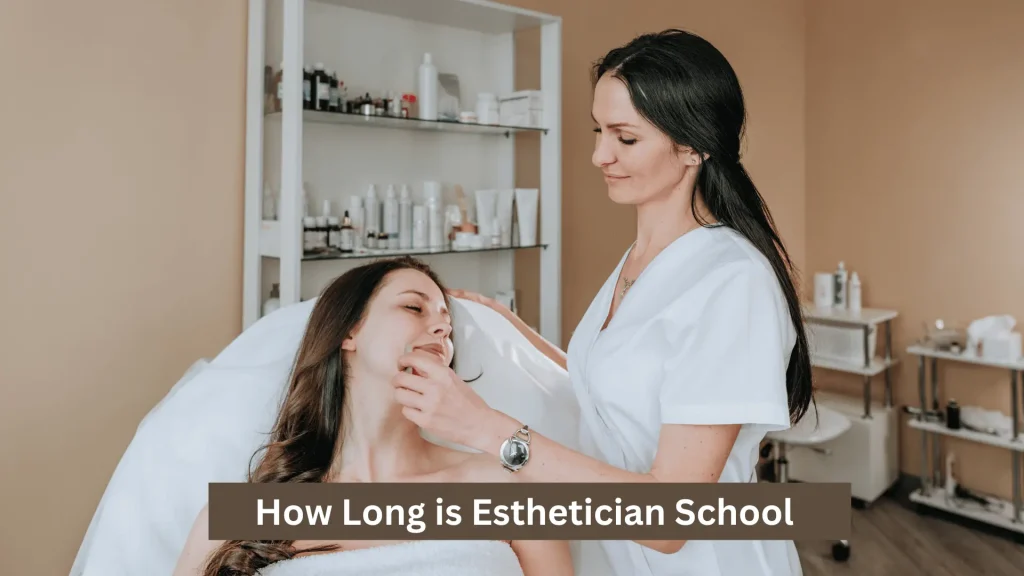How Long is Esthetician School
When considering a career in skincare and beauty, one of the first questions prospective students ask is, “How long is esthetician school?” This crucial detail helps in planning and preparing for the journey to becoming a licensed esthetician.
What is Esthetician School?
Esthetician school is a specialized educational institution where students learn about skincare treatments, facials, hair removal, makeup application, and other beauty-related services. These programs combine theoretical knowledge with hands-on training to prepare students for a career in the beauty and wellness industry.

In esthetician school, students gain expertise in various techniques and the use of professional skincare products and equipment. The curriculum often includes topics such as anatomy, physiology, dermatology, and customer service, all tailored to meet state licensing requirements.
How Long is Esthetician School?
The duration of esthetician school varies depending on the program and state requirements. Here’s a year-wise breakdown of typical esthetician programs:
Certificate Programs (6 to 9 months):
Certificate programs are the most common and usually last between 6 to 9 months. These programs focus on the essential skills needed to become an esthetician, including facials, waxing, makeup application, and basic skin analysis. Students also learn about sanitation practices, state laws, and business ethics related to the beauty industry.
Skin Analysis and Facials: Learning how to analyze skin types and conditions, and performing various facial treatments.
Hair Removal Techniques: Training in waxing, threading, and other hair removal methods.
Makeup Application: Basics of makeup artistry, including color theory and application techniques.
Sanitation and Safety: Proper sanitation practices and adherence to state regulations and guidelines.
Diploma Programs (9 to 12 months):
Diploma programs often extend up to a year and provide a more comprehensive education. In addition to the basic skills covered in certificate programs, diploma students delve deeper into advanced skincare techniques, such as chemical peels, microdermabrasion, and other specialized treatments. These programs may also include modules on spa management and customer service skills.
Advanced Skincare Treatments: Chemical peels, microdermabrasion, and other specialized treatments.
Anatomy and Physiology: In-depth study of skin structure, functions, and common skin disorders.
Business and Ethics: Fundamentals of running a beauty business, customer service, and ethical practices.
Hands-on Practicum: Extensive practical training in a salon or spa setting to gain real-world experience.
Associate Degree Programs (2 years):
For those seeking an in-depth education, associate degree programs in esthetics can take up to 2 years to complete. These programs offer a broader curriculum that covers not only advanced skincare treatments but also subjects like anatomy, physiology, nutrition, and business management. Graduates with an associate degree may find more opportunities for career advancement and specialization within the beauty industry.
Advanced Anatomy and Dermatology: Detailed study of skin biology, diseases, and advanced dermatological treatments.
Nutrition and Skin Health: Understanding the impact of diet and nutrition on skin health and beauty.
Spa Management: Skills for managing and operating a spa, including marketing, finance, and client relations.
Electives and Specializations: Options to specialize in areas such as medical esthetics, laser treatments, or holistic skincare.
Capstone Project or Internship: Completing a final project or internship to demonstrate proficiency and gain professional experience.

How to Enter Esthetician School
Educational Requirements:
High School Diploma or Equivalent: Most esthetician schools require applicants to have a high school diploma or a General Educational Development (GED) certificate.
Prerequisite Courses: Some schools may require completion of specific high school courses, such as biology or chemistry.
Entry Tests:
Basic Skills Assessment: Some esthetician schools may require applicants to take a basic skills test to assess proficiency in subjects like reading, writing, and math.
Interview: An interview may be part of the entry process to evaluate the applicant’s interest and commitment to the field.
Application Process:
Application Form: Prospective students need to fill out an application form provided by the esthetician school.
Transcripts: Submission of high school or GED transcripts is typically required.
Personal Statement: Some schools may ask for a personal statement explaining the applicant’s interest in esthetics and career goals.
Letters of Recommendation: Applicants might need to provide letters of recommendation from teachers, employers, or professionals in the field.
Application Fee: A non-refundable application fee is often required.
Financial Aid:
Scholarships: Many esthetician schools offer scholarships based on academic merit, financial need, or specific criteria such as community service.
Grants: Federal and state grants, such as the Pell Grant, can provide financial assistance to eligible students.
Student Loans: Federal student loans, including subsidized and unsubsidized loans, are available to help cover tuition and other education-related expenses.
Work-Study Programs: Some schools offer work-study programs that allow students to work part-time while attending school to help cover costs.
Payment Plans: Many schools offer flexible payment plans to help students manage the cost of tuition over time.
Scope and Demand for Esthetician School Graduates
Career Opportunities:
Spas and Salons: Many estheticians find employment in day spas, resort spas, and beauty salons where they provide a variety of skincare treatments and beauty services.
Medical Esthetics: With additional training and certification, estheticians can work in medical settings, such as dermatology offices and plastic surgery clinics, performing advanced skincare procedures under the supervision of healthcare professionals.
Freelance and Mobile Services: Some estheticians choose to work independently, offering services on a freelance basis or through mobile spa services, providing convenience to clients in their homes or other locations.
Education and Training: Experienced estheticians may pursue careers as instructors in esthetician schools, sharing their knowledge and expertise with future professionals.
Sales and Marketing: Estheticians with strong communication skills may find opportunities in sales and marketing roles within the beauty industry, representing skincare products and brands.
Industry Demand
Growing Beauty and Wellness Industry: The demand for estheticians is driven by the increasing interest in skincare and wellness. Consumers are becoming more conscious of the benefits of professional skincare, leading to a rise in demand for esthetic services.
Aging Population: As the population ages, there is a growing need for anti-aging treatments and skincare solutions, creating more opportunities for estheticians.
Innovations in Skincare: Advancements in skincare technology and treatments, such as laser therapies and advanced chemical peels, require skilled professionals, further boosting the demand for qualified estheticians.
Holistic and Natural Skincare Trends: The trend towards natural and holistic skincare products and treatments has expanded the scope of services offered by estheticians, attracting a broader client base.
Top 10 Esthetician Schools

CIDESCO International (Worldwide)
Courses: Diploma in Beauty Therapy, Diploma in Spa Therapy, Diploma in Aromatherapy.
Aveda Institute (USA)
Courses: Esthiology, Advanced Esthetics.
International Dermal Institute (Worldwide)
Courses: Advanced Esthetics, Dermal Science.
Christine Valmy International School (USA)
Courses: Basic Esthetics, Advanced Esthetics, CIDESCO International Diploma.
London School of Beauty & Make-Up (UK)
Courses: CIDESCO Beauty Therapy, VTCT Level 3 Diploma in Beauty Therapy.
Elizabeth Grady School of Esthetics and Massage Therapy (USA)
Courses: Esthetics Program, Advanced Esthetics Program.
Steiner Training Academy (UK)
Courses: Advanced Aesthetics, Beauty Therapy.
Australian National College of Beauty (Australia)
Courses: Diploma of Beauty Therapy, Certificate IV in Beauty Therapy.
New York Institute of Beauty (USA)
Courses: Esthetics Program, Advanced Esthetics.
Academy of Professional Cosmetology (USA)
Courses: Esthetics, Advanced Esthetics.
Factors Affecting the Length of Esthetician School
State Licensing Requirements: Different states have varying requirements for the number of training hours needed to qualify for licensure.
Type of Program: Certificate programs are generally shorter than diploma and associate degree programs.
Part-time vs. Full-time Enrollment: Full-time students complete the program faster than part-time students.
School Curriculum: Some schools may offer more extensive curricula that cover additional topics and skills, extending the program length.
Specializations: Programs offering specializations or advanced training may take longer to complete.
Student Pace: Individual student pace and ability to complete coursework and practical hours can affect program length.
Hands-on Training Requirements: The amount of hands-on training and practical experience required can influence the duration of the program.
Availability of Courses: The frequency and availability of courses and classes can impact how quickly a student can progress through the program.
Final Verdict
So, how long is esthetician school? The answer depends on various factors, including the type of program, state requirements, and individual pace. Typically, it can range from 6 months for certificate programs to 2 years for associate degree programs. Understanding these variables can help prospective students choose the right program and plan their educational journey effectively.
FAQs
1. What is the difference between a certificate and a diploma in esthetics?
A certificate program is usually shorter and focuses on basic esthetician skills, while a diploma program offers more comprehensive training, including advanced techniques and business skills.
2. Can I work while attending esthetician school?
Yes, many schools offer part-time programs to accommodate working students. However, balancing work and study requires good time management.
3. Do esthetician programs include hands-on training?
Yes, practical hands-on training is a crucial part of esthetician programs, allowing students to practice techniques on real clients.
4. What are the licensing requirements for estheticians?
Licensing requirements vary by state but generally include completing an accredited program and passing a state board exam.
5. Are online esthetician programs available?
While some theoretical coursework can be completed online, hands-on training must be done in person. Hybrid programs offering both online and on-campus components are available.
